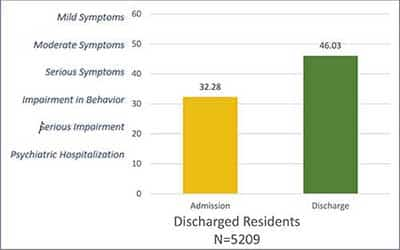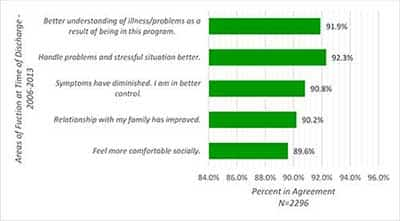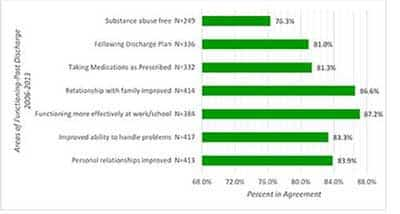Timberline Knolls has helped thousands of women facing eating disorders, addiction, and mood disorders. As a nationally recognized treatment center, we strive to provide innovative care.
Timberline Knolls Residents: Functional Improvement, 2006-2013
* Global Assessment of Functioning (GAF) Scale 0-100

Based on the Global Assessment of Functioning (GAF) scale, residents at Timberline Knolls usually enter treatment at a level of “impairment” and discharge with “moderate symptoms” that can be addressed in step-down services, including outpatient treatment and support groups. This improvement is indicated by GAF scores averaging from 32.28 at the point of admission to 46.03 when discharge occurs.
* Axis V: Global Assessment of Functioning (GAF) is for reporting the clinician’s judgment of the individual’s overall level of functioning. The information is useful in planning treatment and measuring its impact, and in predicting outcome. The reporting of overall functioning on Axis V can be done using the Global Assessment of Functioning (GAF) Scale. The GAF Scale may be particularly useful in tracking the clinical progress of individuals in global terms, using a single measure.
American Psychiatric Association. (2000). Diagnostic and Statistical Manual of Mental Disorders (Revised 4th ed.). Print. Washington, D.C: Author, p. 32.
Timberline Knolls Residents: Functioning at Discharge, May 2006 – December 2013

Therapeutic communication is a constant at Timberline Knolls and specific, direct feedback from residents is sought as they near the end of their treatment on campus and ready for a life with newly acquired skills.
Presented here are ongoing results of the Resident Functioning at Discharge Survey of Timberline Knolls residents. Residents’ self-evaluations demonstrate high ratings for areas of functionality, further substantiating the treatment gains made at Timberline Knolls.
Exclusions: Not all TK alumnae complete and return the one-year post discharge survey and not all questions are answered. These numbers represent a small sampling of former residents.
Timberline Knolls Residents: Functioning at One Year Post-Discharge, May 2006 – December 2013

Timberline Knolls staff works to maintain communication with former residents through our alumni program, including alumni events (held both on and off campus), and conducts a one-year post-discharge follow-up survey.
Results from Timberline Knolls former residents indicate they are handling various areas of function in positive ways, and using their skills learned during treatment to move forward to live constructive and meaningful lives. Residents’ self-evaluations show high ratings for several important areas of functionality.
